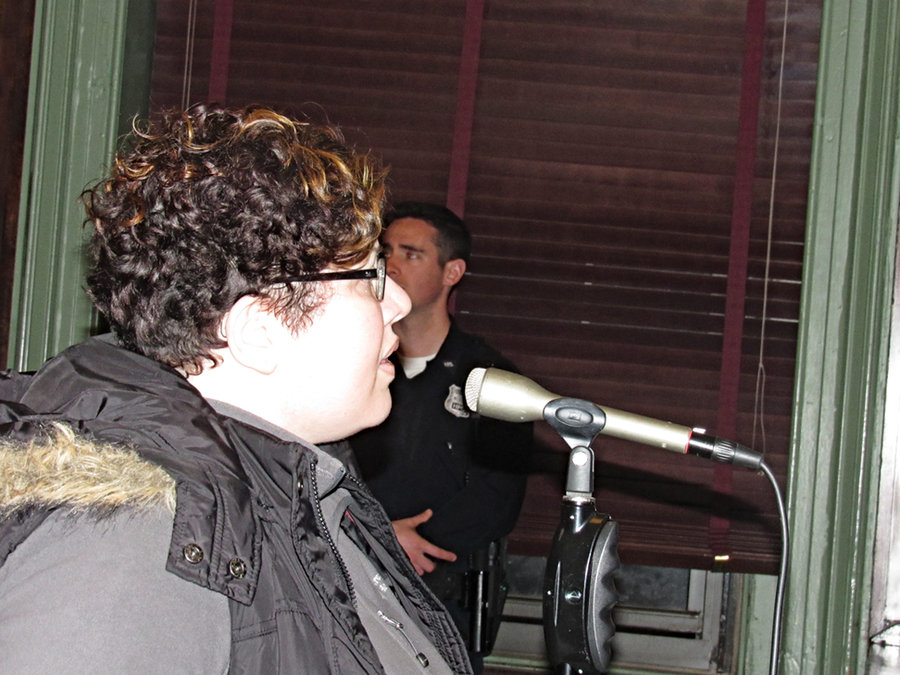This past week, Stevens Institute of Technology received unanimous approval from the City Council for a new glass sky bridge – a structure not exactly typical for Hoboken.
The sky bridge is part of the college’s recently approved two-building $63.5 million Academic Gateway Complex on Hudson Street near Sixth Street.
Back in November, when the complex was being considered, a handful of residents said the bridge threatened the character of the residential neighborhood. Others, including the majority of the Zoning Board of Adjustment, saw it as a benefit to the community. The sky bridge was expected to need easement approval from the council since it “infringed in the public right of way.”
In a surprising turn of events, at this past week’s meeting on Wednesday, April 6, it turned out that any hand-wringing over the easement was in vain.
“We found out after the zoning board meeting that we own that land,” said Stevens Chief of Staff Beth McGrath. “We found a deed from 1964.”
The discovery meant that what was initially an easement request turned into a relatively straightforward right of way agreement.
The resolution for the agreement passed unanimously at the council level.
After the vote, Stevens officials told the Reporter in the hallway of the council chambers that they do not intend to divert from the design passed last November.
The 90,000 square foot complex is made up of the two four-story buildings on the north and south sides of Sixth Street where it meets Hudson Street. In all, the Gateway Complex is about 66 feet tall, similar to the Carnegie building to the south at 64 feet, and the Union Club to the west at 62 feet.
The new complex, which Stevens plans to erect by 2017, will add 11 classrooms, 10 labs, and 45 offices.
Traffic in the south
After 4th Ward Councilman Ruben Ramos fought to get a 90-day pilot program for Jackson Street traffic onto the City Council agenda since January, the council instead decided on Wednesday to study traffic in the southwest on broader terms.
The initial proposed program was intended to relieve the bottleneck that is typical for Jackson Street between Newark Street and Observer Highway, near the city’s border with Jersey City. Since 2012 the street has functioned as a one-lane street as opposed to two.
Maser Consulting plans to study traffic patterns in the city’s southwest corridor to improve movement during rush hour.
____________
The pilot would have limited parking to one side of the street and painted over the bike lane that runs near the middle of the road. However, the $28,000 traffic study (paid for by the city and approved on Wednesday) will now require engineer firm Maser Consulting to simply study the traffic patterns in the area.
“Back in January they didn’t recognize the problem and now they do. That was my goal,” Ramos said after the meeting.
At the time Ramos brought the proposal to the municipal dais, Mayor Dawn Zimmer expressed concerns over the dangers of rushing into a street reconfiguration without proper analysis.
“There were some liability issues there as well with changing the streets and not doing it by ordinance,” added Ramos. “If there was an accident for instance there the city could become liable as well, and we wanted to avoid that.”
The study will analyze movement across 10 intersections in the area including where Newark Avenue and Jackson Street meet, and the Hudson Bergen Light Rail crossing on Paterson Plank Road near First Street (where a signal is said to sometimes run up to eight minutes long causing traffic backups in and out of the city).
Ramos said the study will take less time than the 90-day pilot program to conduct. It is scheduled to begin this week but the councilman could not say when results will be in.
Sounding off on city improvements
In the midst of budget season, one lifelong Hoboken resident at the council meeting this past Wednesday sounded off on a number of issues.
Theresa Hunt, 44, whose family has lived in the Mile Square City since as early as the 1940s, asked about the city’s proposed $107 million budget, to be approved next month. The budget is up from $103 million last year. Hunt asked, with a budget expected to increase by 3.5 percent, where’s the payoff?
“It’s getting tougher and tougher to live in this city. The taxes are being raised and the city looks like it’s in shambles,” Hunt said during the public comments portion of the meeting. “There are more and more bike lanes and less parking, it takes my family at least two hours to find parking on 12th Street. They can’t afford parking lots.”
She also lambasted the number of potholes in the city.
The Board of Education budget will also climb from $67.9 million to $69.7 million.
The budgets have merely been introduced and won’t be finalized likely until May.
The city has said that the major cost drivers for the budget are the payment of health premium costs for city workers, capital improvement projects, and well as building and park renovations. The school board similarly blames health costs, new teachers, and charter school funding for its expected tax increase.
Hoboken property owners pay property taxes to the city, county, and public schools, as well as smaller taxes to fund open space and the public library. The county budget will be introduced in May or June.
Despite the city often pointing the finger to the county’s tendency to increase Hoboken taxes, residents want to see the city better itself, according to Hunt.
“How we can work together [with the Board of Education] to really reduce that number as well?” asked 3rd Ward Councilman Michael Russo after Hunt’s comments. “’cause if we’re doing it here and the school board is doing it there, that’s two thirds of the pie that we are trying to reduce on a yearly basis.”
Steven Rodas can be reached at srodas@hudsonreporter.com.
